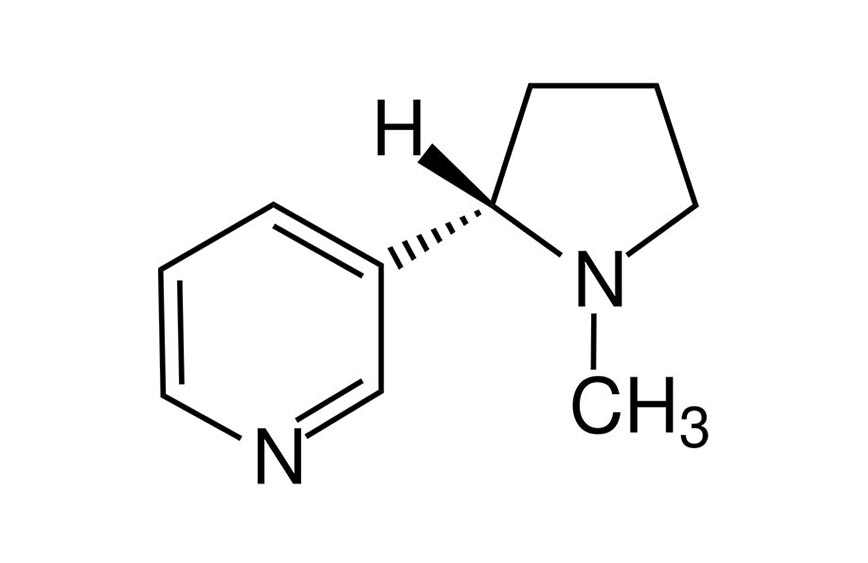Active principles of Mapacho: Nicotine
The main active principle of the mapacho plant is nicotine.
Nicotine is found especially in the mapacho plant (Nicotiana tabacum and Nicotiana Rústica): it has a high concentration in its leaves, about 5% of the weight of the plant and 3% of the weight of the dried mapacho).
Nicotine is also present in a marginal way in other plants of the Solanacea family (2–7 µg/kg); tomato, eggplant, pepper and potato. In even more marginal quantities, in plants such as cauliflower, green pepper or black tea.
Molecule:
Structure: It has two mononitrogenous heterocyclic nuclei: a pyridine ring and a pyrrolidine ring.
Biosynthesis: It is synthesized in the areas of greatest activity in the roots of mapacho plants and is transported by the sap to the green leaves.
Pharmacology:
Interactions: Smokers metabolize a variety of substances more rapidly than nonsmokers. Drugs affected include theophylline, propranolol, phenacetin, atenolol, nifedipine, imipramine, benzodiazepines, caffeine, and opioids.
Dependence: Nicotine is one of the most addictive psychoactive substances in existence.
Withdrawal: Craving, anxiety, irritability, difficulty concentrating, fatigue, headache, depression, constipation, increased appetite, cough, insomnia, and drowsiness are observed.
Suppressed psychological traits, e.g., users with a prior history of depression may experience a flare with withdrawal.
Signs and symptoms of tobacco withdrawal, Arch Gen Psychiatry 1986; 43:289-294.


Effects:
On the central nervous system: It produces central stimulation. Most of the behavioural effects of nicotine are produced by the activation of nicotinic receptors in the CNS.
It stimulates vigilance, alertness and cognitive performance (low doses).
At the brain level: It acts on the presynapse and reinforces the release of neurotransmitters such as acetylcholine, dopamine, noradrenaline and serotonin.
Cigarette smoking: the need for action by health professionals. 1988
Pharmacology of nicotine. Natcher Conference Center National Institutes of Health; 1998
On the limbic system: It has a rewarding effect on the limbic system, mediated by the neuronal pathway of pleasure (high doses).
On the cardiovascular system: peripheral vasoconstriction, tachycardia and hypertension.
In both smokers and non-smokers, nicotine administration produces a significant increase in systolic and diastolic blood pressure and heart rate. There is also an increase in the number of leukocytes, platelets, fibrinogen and hematocrit, and an increase in coagulation.
Pharmacology of nicotine. Br Jaddict 1989; 84:477-492.
Platelet sensibility to prostacyclin in smokers and non-smokers. Chest 1986; 90:34-38
Smoking produces an increase in plasma concentrations of several hormones, adrenocorticotropic hormone (ACTH), cortisol, growth hormone (GH), prolactin and vasopressin.
Activation of the adrenal medulla releases noradrenaline and adrenaline.


MECHANISM OF ACTION:
Receptors: Nicotine produces neuronal excitation by producing the opening of nicotinic cholinergic receptors, to which it is selectively attached.
It selectively binds to nicotinic cholinergic receptors, presenting an activating action at first and a blocking action later.
MEMBRANE PASSAGE:
SMOKING: The passage of membranes depends on the balance between the ionized and non-ionized forms of Nicotine, which depends on the pH of the medium.
– When the medium is basic, nicotine tends to be non-ionized, is fat-soluble and easily crosses biological membranes.
In cigar cigars and pipe Mapacho, which are alkaline, nicotine is absorbed more through the oropharyngeal cavity without the need for the smoke to be swallowed.
-When the medium is acidic, nicotine tends to be ionized and has difficulty crossing biological membranes.
Cigarette smoke, which is more acidic, has to be inhaled, with nicotine being absorbed especially in the lung, due to its more alkaline pH.
The faster the absorption of a substance, the higher the plasma levels are reached and the faster their fall.
As absorption is faster, cigarettes achieve greater and shorter nicotine peaks than with cigars and pipes.
The addictive capacity of a substance depends directly on how quickly its central actions occur and how intense they are. Because of this, inhalation is a particularly addictive way of administering a substance.
Armitage AK,Turner DM. Absorption of nicotine in cigarette and cigar smoke through the oral mucosa. Nature,1970 1231-1232
Pharmacology aspects of cigarette smoking and nicotine addiction. N Engl J Med 1988; 319:1,318-1,330
Review of the evidence that pH ia a determinant of nicotine dosage from oral use of smokeless tobacco. Tob Control 1997; 6:219-225


ORALLY:
Oral and chewing preparations undergo a first hepatic passage, lower concentrations of nicotine reach the systemic circulation and, in part, for this reason they have a lower addictive power.
Distribution:
Once in the body, nicotine is quickly distributed to the blood and tissues, since at blood pH it crosses cell membranes easily. Due to its high lipid solubility, it crosses the blood-brain barrier.
After smoking a cigarette for about ten minutes, the peak plasma concentration of nicotine rises to about 25-45 ng/ml.
Arteriovenal Difference: Arterial levels are six to ten times higher than venous levels.
– At the end of the day, higher nicotine levels usually occur due to an accumulation after several hours of regular smoking.
– Eating food produces an increase in hepatic blood flow and a consequent greater clearance of nicotine, which would explain the urgency with which some consumers have to smoke after eating.
Variables affecting nicotine metabolism. Pharmacol Ther 1993; 60:461-500.
Half-life: Levels are reduced by half in about two hours.
Metabolization: Hepatic: Nicotine is metabolized mainly in the liver, through the cytochrome P450 (CIP) group of enzymes (which eliminate substances that are not synthesized by the body itself), which converts it into cotinine, which is eliminated by the urine.
Cotinine also interacts with the nicotinic receptor, potentially contributing to the neuropharmacological effects of nicotine. Cotinine levels are about ten to fifteen times higher than those of nicotine, since its half-life is longer, about 20 hours.
“Cotinine, the major brain metabolite of nicotine, stimulates nicotinic receptors…” J Pharmacol Exp Ther 1999; 288:905-911
In humans, 70 to 80% of nicotine is metabolized by CYP2A6, of which three variants have been identified: the normal CYP2A6*1, and two others associated with reduced activity of the enzyme. The presence of abnormal variants among smokers is less frequent than among non-smokers. Those people with abnormal variants smoke fewer cigarettes per day and are more successful in quitting.
A common genetic defect in nicotine metamolism decreases smoking.Natcher Conference Center National Institutes of Health; 1998
Pulmonary: A fraction of the inhaled nicotine is metabolized by the lung.
Turner DM,Armitage AK,Briant RH,Dollery CT. Metabolism of nicotine by the isolated perfused dog lung. Xenobiotica, 5 (1975
Elimination: -Nicotine is also excreted in the milk of women who smoke during lactation. Milk from heavy smokers may contain 0.5 mg per liter.
